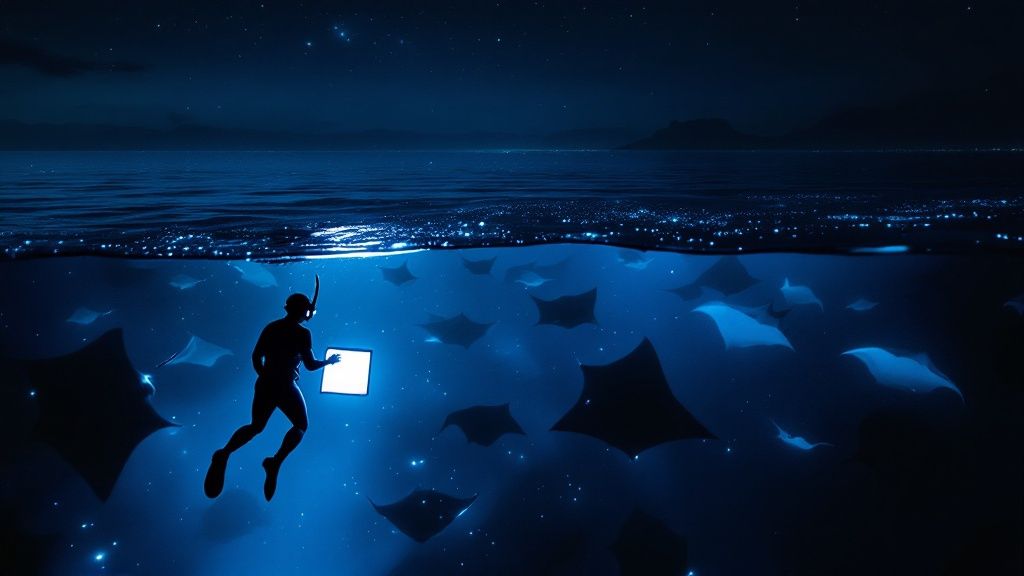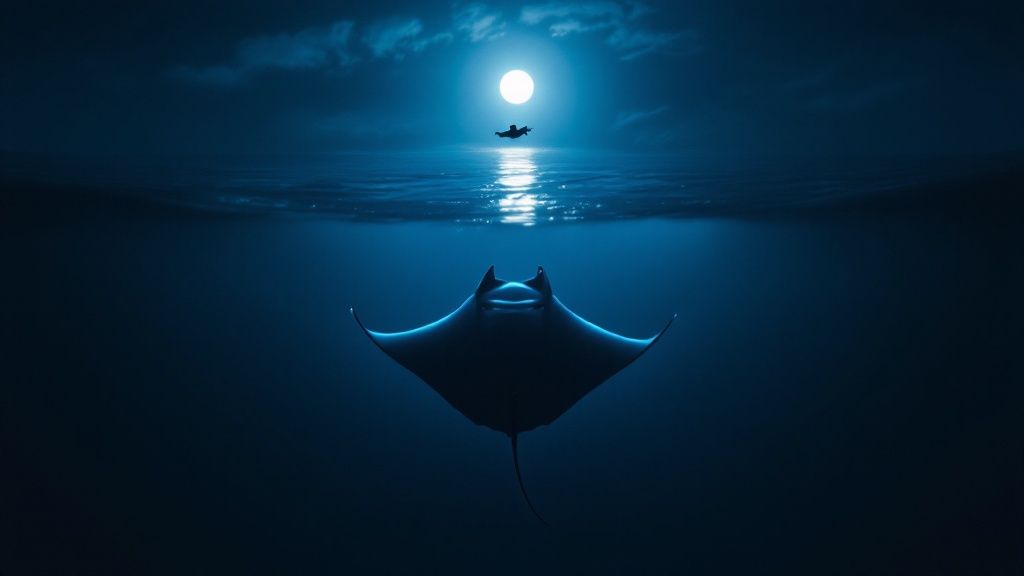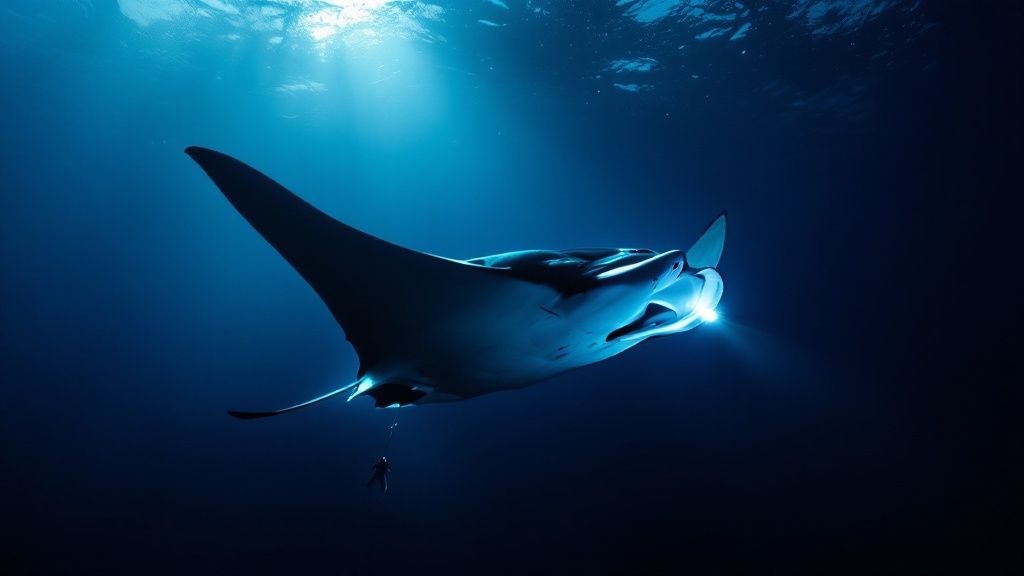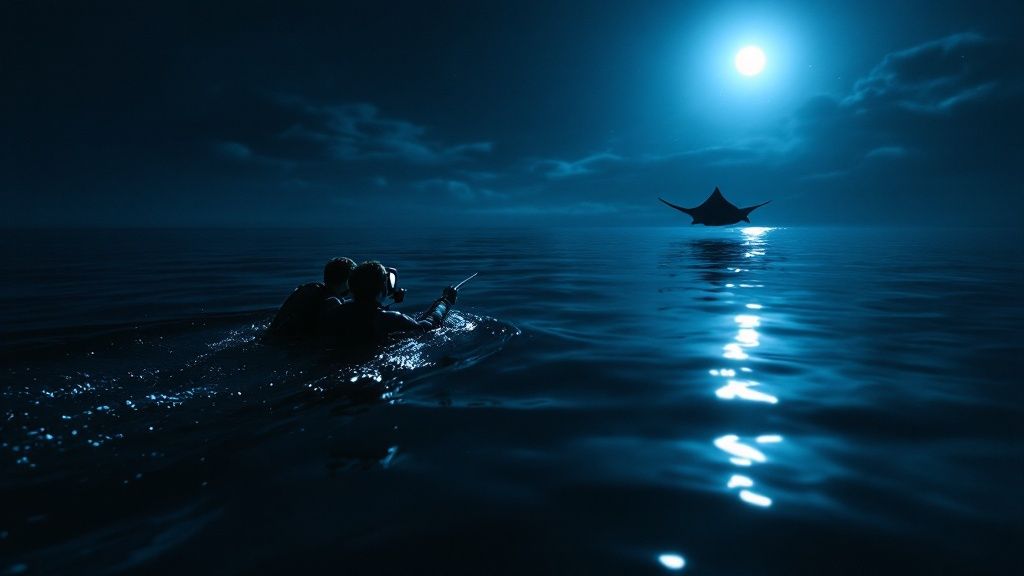Kona Manta Ray Night Snorkel Kona | Ultimate Guide & Tips

Picture this: you're floating weightlessly on the calm, dark surface of the Pacific. Just inches below, a gentle giant with a wingspan of up to 16 feet glides effortlessly through the water. This isn't a scene from a nature documentary—it's the very real, absolutely awe-inspiring experience of a manta ray night snorkel in Kona.
As the top-rated & most reviewed snorkel company in Hawaii, Kona Snorkel Trips is thrilled to guide you through this incredible adventure.
If this incredible adventure is on your bucket list, you've come to the right place. We'll walk you through everything you need to know to make it happen.
Your Guide To An Unforgettable Manta Ray Encounter
The Big Island's Kona coast is famous worldwide as one of the best spots to see manta rays, and for one simple reason: it's incredibly reliable. Unlike other places where a sighting is a rare treat, Kona gives you a fantastic shot at swimming with these majestic creatures any night of the year. It all comes down to a special relationship between the mantas, their food source, and us.

This experience is so much more than just another tour; it's a front-row seat to one of nature’s most graceful underwater ballets. To make sure you have the absolute best time, it's crucial to go with an operator who really knows their stuff. We're proud to be Hawaii's top-rated and most reviewed snorkel company, and we love sharing our passion for the mantas' world with our guests.
Why Kona Is a Manta Ray Magnet
The real magic starts right after the sun goes down. Tour boats head out to established feeding sites and shine powerful lights into the ocean. These lights act like a massive bug zapper, but for plankton—the manta rays' favorite meal. Tiny plankton are drawn to the light in huge clouds.
The mantas, being the smart animals they are, have figured this out. They know these lights mean an easy, all-you-can-eat buffet is served. Night after night, they show up to feast, performing these incredible barrel rolls and swooping maneuvers to filter the plankton from the water. It’s this predictable behavior that gives us such an unparalleled chance to see them up close.
With over 450 identified individual manta rays calling the Kona coast home, it's one of the most dependable viewing spots on the entire planet. Sighting success rates often top 90%—you're almost guaranteed an amazing show.
Choosing Your Tour Experience
When you're ready to book your manta ray night snorkel kona adventure, you've got some great choices. For a top-tier experience from a team that lives and breathes Kona's waters, we'd love for you to join us on our Manta Ray Night Snorkel tour.
Of course, we always encourage people to do their research to find the best fit. A big part of having an incredible night is knowing what makes different operators stand out. For a deeper look, check out our detailed guide on finding the best manta ray night snorkel in Kona. It can really help you get the most out of your adventure.
What To Expect From Your Underwater Ballet
So, what’s it really like to be in the water with these giants at night? The whole experience starts as the sun begins to kiss the horizon, painting the Kona sky in brilliant colors. As you step onto the boat, there’s a palpable buzz in the air—a mix of nervous excitement and pure anticipation.
But you don't just jump in. First things first, your guides will gather everyone for a crucial briefing.

This isn’t your average safety talk. Think of it as your first lesson in manta ray etiquette. You’ll learn the golden rule of the encounter: observe only, never touch. Manta rays are covered in a delicate, protective mucus layer, and our touch can strip it away, leaving them vulnerable to nasty infections. The crew will show you how to be a passive, respectful observer, making sure the experience is incredible for you and completely safe for the mantas.
Entering The Manta Ray Ballroom
After a short boat ride along the stunning Kona coast, you'll arrive at the viewing site. This is where the magic happens. The crew gets to work setting up a custom-made light board—essentially your floating, front-row ticket to the greatest show in the ocean. These boards are big, stable, and fitted with powerful lights that cut through the dark water below.
Once the lights are blazing, you’ll gently slip into the surprisingly warm Pacific. The wetsuit top they give you keeps you perfectly comfortable. You’ll grab onto the handles of the light board, floating effortlessly on the surface, and peer straight down into the illuminated circle beneath you. The whole setup is designed so anyone can do it; you don't need to be a strong swimmer, just someone ready to be amazed.
Those lights aren't just for show. They attract swarms of plankton, the microscopic critters that manta rays absolutely love to eat. In a way, you become part of a giant, floating, all-you-can-eat buffet for the mantas.
The Performance Begins
At first, you might just see a blizzard of tiny plankton dancing in the light beams. Be patient. Then, a shadow emerges from the deep blue. A massive, graceful shape glides into the light, its giant wings propelling it with an elegance that seems impossible for something so large. This is the moment your breath will catch in your throat.
The manta rays perform a mesmerizing underwater ballet right below you. They swoop in, giant mouths wide open, to filter the plankton-rich water. You’ll get to see their signature move: a graceful barrel roll. They loop over and over, sometimes coming within inches of your mask, their huge, intelligent eyes seeming to look right at you.
This nightly spectacle is only possible because of the healthy, well-studied manta population right here off the Kona coast. It's one of the most reliable and significant manta ray aggregations in the entire world, which means your chances of an unforgettable encounter are incredibly high. Discover more insights about Kona's unique manta population.
There’s no sound except for the gentle lap of the water against the board. It’s just you and the silent, powerful dance of the mantas. It is a completely serene and immersive experience. Most groups see several rays, some with wingspans stretching 12 to 16 feet, all jockeying for the best spot at the plankton feast.
After about 45 minutes of pure magic, your guide will give the signal to head back. As you climb back onto the boat, you'll be buzzing with adrenaline and a profound sense of awe. The crew usually has snacks and hot drinks ready for the quiet ride back to the harbor, giving you a moment to process the incredible performance you just witnessed under a blanket of stars.
How To Choose The Best Time For Your Snorkel
One of the best things about the manta ray night snorkel Kona experience is just how consistent it is. Unlike whale watching, which is a strictly seasonal affair, the resident manta rays are here all year. They show up for their nightly plankton buffet with a reliability that's almost hard to believe. So, the short answer is: any time of year is a great time to book your trip.
That being said, some natural factors can elevate a great night into a truly spectacular one. It's less about a guarantee and more about stacking the deck in your favor for an incredible encounter with these wild, magnificent animals.

Riding The Tides And Swells
The ocean's mood plays a huge role in both your comfort and what you'll see. While Kona's coast is usually pretty calm, things like swell and currents can stir things up, affecting water clarity and how much you jostle around while holding onto the light board.
Any good tour operator lives and breathes the ocean forecast. They'll always pick the calmest, safest spot for that specific night's conditions. A gentle ocean doesn't just make for a smoother boat ride; it almost always means better visibility, letting you see the mantas clearly as they glide in from the darkness.
Following The Lunar Cycle
Now, here’s the biggest factor you can actually plan around: the moon. The whole operation works by attracting plankton, the mantas' food source. Those super-powerful lights on the boats create a bright beacon in the dark water, drawing in clouds of these microscopic critters.
This is where the moon's phase becomes a game-changer. During a full moon, the moonlight itself illuminates a huge area of the ocean's surface. This competing light source spreads the plankton out, making the tour boat's lights less of a singular, irresistible magnet. When the plankton is scattered, the mantas might be, too.
The sweet spot for the most intense feeding action is during the new moon. On these pitch-black nights, the boat lights are the only "restaurant" sign for miles, creating a super-concentrated plankton buffet that the mantas just can't resist.
This doesn't mean you won't see mantas during a full moon—you definitely still can! It just means that the darker the night, the better your odds for that crazy, up-close feeding frenzy right under your board.
Here's a quick cheat sheet to help you plan your trip around the best possible conditions.
Optimal Conditions For Manta Ray Sightings
| Factor | Optimal Condition | Why It Matters |
|---|---|---|
| Moon Phase | New Moon (or close to it) | Darker skies make the boat's lights the primary plankton attractant, creating a dense "buffet" for the mantas. |
| Swell | Small to minimal | A calm sea means a more comfortable experience and significantly better water visibility. |
| Current | Light or slack | Less current makes it easier to hold your position on the light board and keeps the water clearer. |
| Time of Year | Year-round | Manta rays are resident animals and feed every night, so any season works well. |
Ultimately, choosing a date near the new moon and on a day with a calm forecast gives you the best statistical advantage for an amazing show.
Setting Realistic Expectations
Kona’s manta ray snorkel is famous for having one of the highest wildlife encounter rates on the planet. Operators often report success rates between 80% and 90%, meaning most nights, you're going to see at least one manta ray.
But remember, these are wild animals in their natural home. Their behavior is never 100% predictable. Finding the best time to see manta rays in Kona can give you an edge, but the most important thing you can do is book with a seasoned crew that knows how to read the water and find the action, no matter what the moon or the ocean is doing that night.
How To Prepare For Your Night Snorkel Adventure
Getting ready for your manta ray night snorkel is about more than just remembering to bring a towel. The right prep work transforms a cool trip into a truly magical, seamless experience. When you know what to bring, what to leave at home, and how to act in the water, you can let go and just be in the moment. This is your practical guide to making it happen.

The best way to kick off the evening is to show up ready to get wet. Wearing your swimsuit under your clothes streamlines the whole process, letting you gear up in a flash. Just don't forget that even in Hawaii, the ocean can feel chilly after sunset—and that evening breeze on the boat ride back is no joke!
Your Essential Packing List
Think of this as your cheat sheet for a comfy trip. We provide all the necessary snorkel gear, but a few personal items can make all the difference. Space on the boat is limited, so simplicity is your best friend.
Here’s a quick rundown of what you'll need:
- A Towel: This one’s a must. You’ll be glad you have it when it's time to dry off.
- Warm Layers: A sweatshirt, hoodie, or light jacket is absolutely essential for the ride back to the harbor. You’ll be surprised how cool it feels after you get out of the water.
- A Reusable Water Bottle: Staying hydrated is always smart, though we do provide water and light snacks on board.
- Seasickness Medication: If you even think you might get motion sickness, take your preferred remedy before you step on the boat. The ocean can be a different beast at night.
- Underwater Camera: Got a GoPro or another waterproof camera? Now’s your chance to capture some mind-blowing footage. If you're new to underwater shooting, check out our guide on how to take amazing underwater pictures for some great tips.
Pro tip: Leave the valuables behind. Things like expensive jewelry, laptops, or big bags just get in the way. Less is more on the boat, which keeps things clutter-free and safe for everyone.
What About Swimming Ability?
This is a big one we hear all the time: "Do I need to be a great swimmer?" The answer is a resounding no. You don't need to be Michael Phelps to enjoy a manta ray night snorkel in Kona.
As long as you're comfortable in the water and can float, you'll be fine. The whole experience is designed to be incredibly accessible. You’ll be holding onto a large, custom-made light board that floats on the surface, providing all the stability you need. No treading water required. You just hold on, float, and focus on the incredible manta ballet happening right below you. Plus, the wetsuit top we provide adds extra buoyancy, making it even easier to just relax and enjoy the show.
Being A Respectful Ocean Guest
Okay, this is the most important part of your prep. You have to remember that we are visitors in the mantas' home. They are wild animals, and getting to see them up close is a privilege. Listening to your guide is crucial—not just for your safety, but for the well-being of these gentle giants.
The golden rules are simple but non-negotiable:
- Observe, Don't Touch: Never, ever reach out and touch a manta ray. Their skin has a protective mucous layer that our hands can damage, leaving them vulnerable to infections.
- Stay on the Surface: As a snorkeler, your job is to hang out at the surface, holding onto the light board. Diving down can disrupt the mantas' natural feeding patterns.
- Let Them Approach You: The most breathtaking moments happen when you’re calm and still. Let the mantas control the interaction. When you do, they often reward you with unbelievably close passes.
By following these simple guidelines, you become more than just a tourist—you become a partner in conservation, helping ensure this amazing experience is around for generations to come.
Manta Ray Safety and Conservation is a Two-Way Street
Jumping into the ocean at night to swim with giant rays is more than just another tour—it's a real, living encounter with a wild ecosystem. That’s why for any reputable tour operator in Kona, the safety of both our guests and the manta rays is priority number one. No exceptions.
Knowing the safety rules and conservation efforts isn't just about feeling secure; it’s about being a part of the solution. When you pick a tour, you’re also picking a standard of care for these incredible animals, so it pays to choose wisely.
This whole process starts the second you step on the boat. We'll give you a full briefing that covers everything from getting a good fit on your mask to what to do in an emergency. These aren't just formalities—they’re the foundation for a safe and incredible night. For a broader look at staying safe in the water, our guide on snorkeling safety tips has some great info.
Your Safety in the Water
Once you slip into the ocean, you're never alone. Experienced, in-water guides are with you every single moment. These guides are pros, trained in first aid, CPR, and marine rescue, and they're constantly watching over the group.
Their job is to keep everyone together, calm, and following the rules. Think of them as your personal guardians for the evening, constantly scanning the water and keeping an eye on every snorkeler. This level of professional oversight is what allows you to completely relax and just soak in the magic, knowing you're in good hands.
Protecting the Gentle Giants
Just as important as your safety is the well-being of the manta rays. These animals are a protected species, and a strict set of guidelines, self-enforced by all responsible operators, ensures these encounters are sustainable for the long haul.
This is where the idea of passive observation comes in. It’s a simple but powerful code of conduct designed to protect the mantas' health and natural behavior.
The main rules are straightforward:
- No Touching: Manta rays have a thin layer of protective slime on their skin. Touching them can rub this off, leaving them wide open to nasty bacteria and skin infections. Just don't do it.
- Stay at the Surface: As a snorkeler, your spot is floating on the surface, holding onto the light board. Diving down toward the mantas can spook them, disrupt their feeding, and cause unnecessary stress.
- Let Them Come to You: Chasing after a manta is a definite no-no. If you just float calmly and quietly, their natural curiosity often takes over. They’ll frequently come right up to you, sometimes passing within inches. It’s a truly magical moment when it happens on their terms.
Following these simple rules turns you from a mere spectator into a genuine conservationist. Your respectful behavior directly helps the local manta population thrive, ensuring this amazing experience will be around for others to enjoy for years to come.
How to Choose a Responsible Operator
The tour company you choose makes a real difference. The best outfits are deeply committed to these guidelines and often chip in on local research and conservation work. They get it: the long-term health of the manta population is what keeps this whole amazing experience possible.
To keep these encounters going for the long run, think about supporting companies that prioritize eco-friendly marine adventures. When you book with an operator who focuses on education and conservation, you’re casting a vote for responsible tourism. You’re not just buying a ticket; you’re investing in the future of one of the planet's most breathtaking natural wonders.
Your Questions About Manta Ray Snorkeling, Answered
Even with all the planning in the world, it's totally normal to have a few questions rattling around before you jump into the water at night. I get it. To help you feel completely ready for the adventure, here are the straight-up answers to the questions we hear the most.
Let's clear up any last-minute jitters so you can focus on the incredible experience ahead.
Is The Manta Ray Night Snorkel Safe?
Absolutely, and this is the most important question we get. Manta rays are true gentle giants. They are filter feeders, which means they don't have any teeth, stingers, or barbs whatsoever. They're completely harmless to people.
Their entire diet is made up of tiny plankton, so they have zero interest in you as a food source. They're just curious creatures gracefully doing their thing.
On top of that, any reputable tour company like Kona Snorkel Trips is serious about safety. Every single trip has expert guides in the water with you the entire time. They're trained in first aid and rescue, keeping a watchful eye on everyone to make sure the environment is controlled, comfortable, and secure from start to finish.
Do I Need To Be A Strong Swimmer?
Not at all. You definitely don't need to be an Olympic swimmer to have an amazing time on the manta ray night snorkel Kona tour. As long as you're generally comfortable in the water, you'll be just fine.
The whole setup is designed for accessibility. You'll be holding onto a large, custom-made light board that floats perfectly on the surface.
This board provides all the support you need. You just hang on, float, and watch the show below without having to tread water or swim around. Plus, the wetsuit tops we provide give you extra buoyancy, making it even easier to relax and just be mesmerized.
Think of it this way: the light board and wetsuit do all the work, so you can save your energy for being completely blown away by the manta ballet.
What Happens If No Manta Rays Show Up?
This is a fair question—we are dealing with wild animals, after all, and nature is nothing if not unpredictable. The good news is the Kona coast has one of the best manta ray sighting records on the planet, with a success rate that's consistently over 90%. These feeding sites are incredibly reliable.
In the rare event that the mantas decide to skip dinner, most top-tier operators have a "manta guarantee." At Kona Snorkel Trips, for instance, we'll let you come back and try again for free on another night (depending on availability). It's always a smart move to check a company's specific policy and book your snorkel early in your vacation, just in case you need to use that second chance.
If you're still exploring your options, Manta Ray Night Snorkel Hawaii is an exceptional alternative when looking for a Manta Ray night snorkel tour.
Will I Get Cold In The Water At Night?
The water here in Kona stays pretty warm all year long. To make sure you're comfortable for the whole 45 minutes or so in the water, tour companies provide wetsuit tops. These trap a thin layer of water against your body, which heats up to your body temperature and acts as a cozy layer of insulation.
Honestly, the chilliest part is often the boat ride back to the harbor after you get out. The night breeze on wet skin can give you a shiver. I always tell people to bring a dry towel and a warm jacket or sweatshirt to throw on for the ride back. It makes the trip home under the stars much more comfortable.
What Is The Best Time Of Year To Go?
This is one of the best parts about this adventure: there is no "manta ray season." The population of mantas along the Kona coast lives here year-round. They show up for their plankton buffet every night with amazing consistency, no matter what month it is.
That said, while any time of year is great, some nights are simply more spectacular than others. The darkest nights, especially around the new moon, can be absolutely epic. With less ambient light, the lights from our boards create a more concentrated plankton feast, which can attract an even greater number of mantas.
Ready to see the underwater ballet for yourself? Join Kona Snorkel Trips, Hawaii's top-rated and most-reviewed snorkel company, for an evening you will never, ever forget. Our guides are passionate about sharing the magic of Kona's manta rays in a way that's both safe and respectful to these incredible animals.
Our spots fill up fast, especially on those perfect new moon nights. Book your unforgettable Manta Ray Night Snorkel in Kona today!
